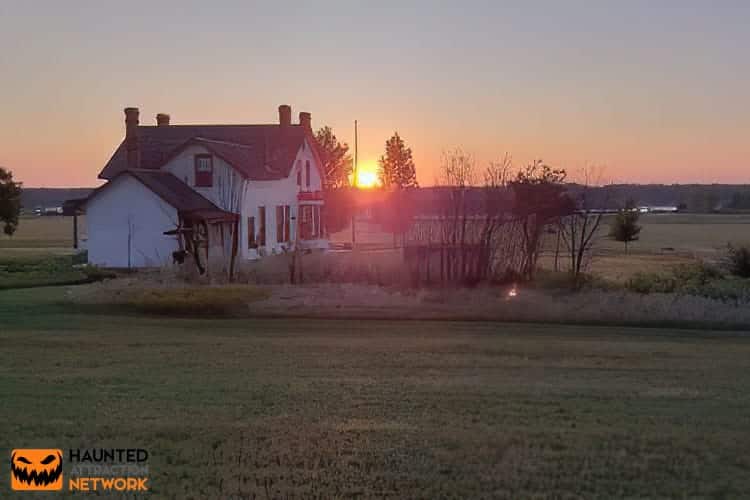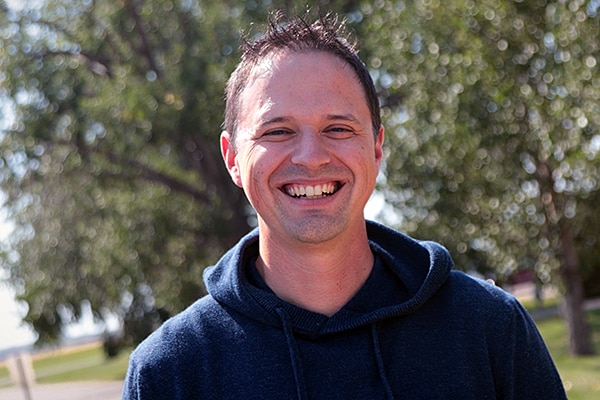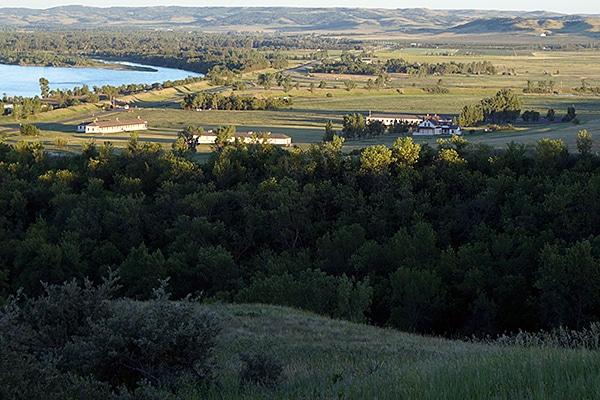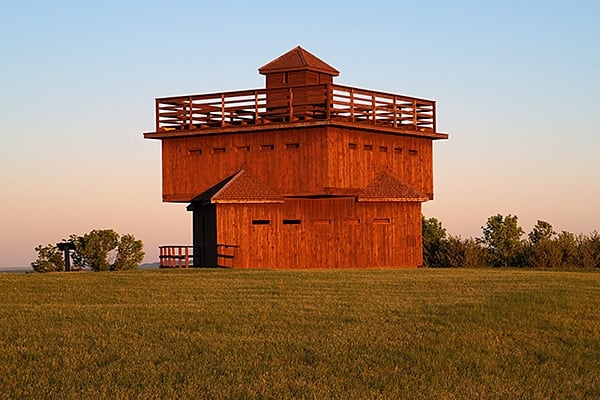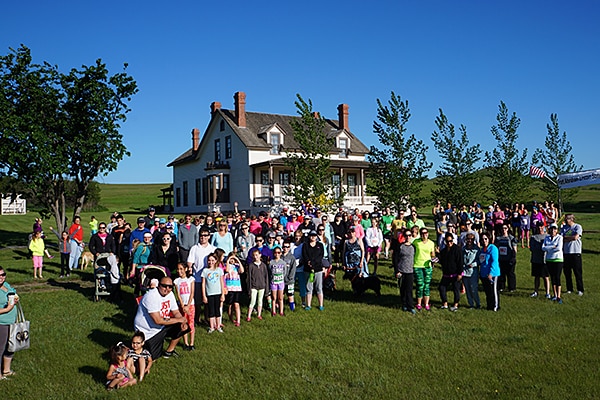Too Tired to Read? Listen Here:
Matt Schanandore, Interpretive Director at Fort Abraham Lincoln Talks about How a Seasonal Haunt Revitalized This Historic Site
Matt Schanandore is the interpretive director at Fort Abraham Lincoln State Park in Mandan, North Dakota and the creative director for Haunted Fort, hosted at the State Park every October. This annual Halloween event has become a significant destination and turned the tide on a steady decline in visitors to the historic site.
As mentioned in the introduction in this issue, the Key Elements for success include: creating a plan complete with funding, obtaining full internal support, pulling in outside help for build-specific skills, crafting a story that builds on the local history, and establishing a dedicated team to work on the event year-round. Haunted Fort did, indeed, devise a plan that incorporated funding for a seasonal event that was fully supported by staff as well as crafting a story for its Halloween event that was inspired by the site’s history. The Fort doesn’t have the infrastructure to bring in outside help nor is it able to create a dedicated team to work on the event year-round, but, in this article, we’ll hear, in Schanandore’s own words, how successful this event has become.
The Backstory on Haunted Fort
Fort Abraham Lincoln was an old military post that was active in the 1870s before North Dakota became a state. The fort was a cavalry post and had about 700 soldiers, officers, civilians, laundresses, and other staff on site at any given time. “Its claim to fame is that the first commanding officer of the fort was General George Armstrong Custer, who had previously been a Civil War hero. Custer was here for about three years before he took part in the battle of Little Bighorn in Montana, where he was killed. His fame blossomed into a North Dakota legend from that point forward,” stated Schanandore.
“The winters at the fort get very cold, and men often froze to death in their bunks. On top of that, men were gruesomely killed in squabbles in the saloon towns near the fort, or they drowned in the river. There were a lot of these tragic stories out here in the Dakota territories—stories of soldiers that would hang themselves in the buildings here at the fort and so on. As a result, there started to be reports of paranormal phenomenon, and that continues to the present day,” he explained.
Schanandore continued, “In the 1890s the fort was torn down. All the buildings were leveled, and the area was opened for farming. About 90 years later, local non-profit organizations and historical restoration groups decided they wanted to rebuild the quarters that General Custer stayed in. In 1989, a replica of his house was rebuilt here on the grounds, and that was followed by the reconstruction of other buildings that had once existed at the Fort.”
Current Activities at Fort Abraham Lincoln
The Fort offers living-history tours of the Custer House. The thirty-minute tour takes guests to the year 1875 when Custer and his wife lived at the Fort. Guides are dressed in period attire as soldiers or laundresses. Interpretive tours of On-a-Slant Village, a 16th century Mandan settlement, and earthen lodges educate visitors about Mandan culture. There’s also a historical museum featuring the culture and history of On-A-Slant Village, Fort Abraham Lincoln, and Fort Lincoln State Park. Visitors can walk through the cavalry barracks, the stables, and the blockhouses. A gift shop and coffeeshop have been built in the re-constructed commissary storehouse. During the summers—melodramas, including ones originally performed at Fort Lincoln in the 1870s—are performed by the guides in the re-built granary.
Ghosts to the Rescue!
“By the early 2000s, attendance at the park was beginning to decline, especially in the off-season months of September and October,” continued Schanandore. “The park staff began to brainstorm about what type of activity or event that we could have, particularly in October when tourists are minimal, we still have staff here, and people continue to visit. A small Halloween event came out of those brainstorming sessions, and Haunted Fort was created.”
The Haunted Fort originally started as a historical haunt. It was an after-dark, guided tour by lantern through the old Custer house. “People loved it. They loved this behind-the-scenes, nighttime tour of the Victorian-style house,” said Schanandore.
“Haunted Fort grew from that into tours of the central barracks where the enlisted men stayed. The stories that came out of there of men freezing to death in their beds, as well as reports from the Fort rosters and the post surgeon, inspired us to create stories about the Fort. Eventually, the event became a full tour of all the buildings,” he stated.
“However, we couldn’t diverge from the actual history of the Fort, and there were only so many stories that could be told. Interest in the Fort continued to decline. Events saw fewer and fewer numbers. So, we took a new approach after seeing some of the other haunted attractions around the country and what they were doing to draw in people and create a unique Halloween experience. At that point, Haunted Fort made a major transition. We dropped the historical aspects of the tour and went with a more modern haunted house with assets that people were more familiar with in haunts like clowns and spirits and demons. We incorporated these slowly into the event, and it took off from there, growing exponentially from one weekend to four weekends a year. Now we run an average of 10 nights throughout the season. We’re coming up on our 17th season,” he said.
Sidebar: Pivoting from Historical to Horror
The Haunted Fort event started in 2002 and the historical themes of that first couple of years were received well by the public. “The reason it played in so well is that here at Fort Abraham Lincoln, we use a unique, first-person interpretation. Our guides aren’t in ranger or park uniforms. The men wear traditional soldiers’ uniforms, and the women we hire during the summer are in typical laundresses’ outfits. During the tour, we take people back in time and present the tour as if we’re in the year 1875. General Custer is alive and living in the commanding officer’s quarters. Mrs. Custer is on the post and preparing to throw a social event that night.
For Haunted Fort, our thought process was to take that first-person interpretation and put it into an actual haunted space. Guests began the tour at 8 o’clock at night when it was dark. The Victorian-style house was lit with the typical kerosene lanterns available in 1875.
Sidebar: Building the Story
Schanandore’s staff uses tales of the paranormal and the ghosts reported during the 1870s as part of its story-building concept. The haunt was designed based on Elizabeth Custer’s writings and the writings of soldiers and laundresses of the period, which were used to develop legendary ghost stories.
“One of the stories we told was about a messenger who came from the ferry in July of 1876 to give the news to the wives here at the fort of the devastating losses at the battle of the Little Big Horn. It was said that when this soldier came in and told her what happened, Elizabeth Custer, as the General’s wife, told him that she would go to the officers’ quarters and tell each officer’s wife that her husband had perished at this battle. She felt that it was her role to do,” explained Schanandore. “We took that story and played it out. You can still hear the voices of these women sobbing and talking about this tragedy in the dark under the light of flickering lanterns.”
Changing the Narrative to Stimulate Repeat Visits
For two years, everyone liked the historical narrative of Haunted Fort. However, by the third year, people started to get bored. “By the fourth year, our numbers had dropped to a quarter of what they’d been two years previous. We contemplated ending it because it was taking too much time, too much effort, and it cost us too much. The purpose of the event to produce revenue for our historical programs during the summer wasn’t panning out,” he said.
The reason for the decline in interest is the haunt began to encounter the same problems as the museum and historic site—which are the same as those of similar places around the country. “Things get stagnant. People go once, they see all the exhibit, they hear the history, they hear the tour, and they don’t come back for another five or 10 years unless they have family in town,” stated Schanandore.
“So, we made the risky leap of saying, okay, we’re done with the historical aspects of the haunt, but we’ll continue to utilize the historical legends, myths, and stories in our theme. Now when people come out, they’re going to experience a true haunted attraction, and we’re going to bring out the thing that scares people today, from chainsaws and clowns.”
Taking the Fort from Closed in October to a Major Seasonal Event
“This facility isn’t used in October. If we’re not here, it’s closed. There’s been a big push over the last 10 years within North Dakota’s government to utilize our facilities and resources to their fullest potential. So, we started using the empty buildings to create our four haunted houses,” Schanandore explained. “Flash forward to 2018. We’re seeing more foot traffic coming through in the month of October than we do at the height of our season in July. The revenue coming in for October is double, sometimes triple, the revenue received from May through mid-September for our usual interpretative tours. In short, the historic site went from stagnant to stupendous with the addition of Haunted Fort.”
Expanding the Visitor Base
Schanandore continued, “In the last few years, the number of out-of-the-area visitors coming to Haunted Fort has grown as we started to project and take ownership of the event. Back in 2012 and 2013, our marketing was just, ‘Come to Haunted Fort.’ At Fort Lincoln, we get nearly 100% of our visitation from the metro area of Bismarck and Mandan. In 2016, we began to brand the event as North Dakota’s premier haunted attraction and our branding has been based on the North Dakota’s tourism branding, which uses the term ‘legendary’ in all their campaigns. We began to brand Haunted Fort as North Dakota’s legendary Halloween event. By doing that, we’ve been not only drawing our repeats from the Bismarck and Mandan area, but now we’re drawing from cities like Dickinson, which is about 90 miles from our location and other metro areas as well such as Minot, which is about 100 miles away,” said Schanandore.
The Challenges of Having an Attraction in a Historical Site
“A state agency runs fort Abraham Lincoln State Park, so everything’s based on expenses. A program like our historical interpretative program—our normal summertime program—doesn’t make money, and it doesn’t even come close to breaking even. Most historical programs like ours are very similar. You can’t charge $20 or $30 for a ticket to visit the Custer house. Families can’t afford it. So, the ticket price of $7 and $5 to visit throughout the summer only produces so much revenue. When you’ve got a staff base of 12 to 15 who are handling tours, the visitor center museum, and concessions operations, you just aren’t making any money,” said Schanandore.
“However, the purpose of our historical site isn’t to make money but to provide an educational experience for the visitors coming through. That’s been our mission as interpreters and historians—to provide that experience for the visiting public. That said, we have to be fiscally responsible for providing a program that’s not costing the taxpayers’ money. Even though it’s a program that the state provides, we’re trying to be responsible in that way,” he noted.
“Running Haunted Fort costs us more than not running it, but the return is well worth it. Because it doesn’t have any historical significance in the eyes of some, Haunted Fort’s main value is producing enough revenue to sustain our interpretive tours and educational programs that we do from May through September. If it weren’t such a valuable asset in funding these programs, Haunted Fort wouldn’t happen anymore,” said Schanandore.
The program at Fort Abraham Lincoln continues to operate in the red every year. However, the revenue generated from Haunted Fort helps to offset that deficit, and the site now runs in the black by including this event.
Sidebar: Future Dreams for the Fort
“I’d like to go back to a blend of the historical parts of the fort and the modern attraction and incorporate some other areas of the Fort, like the old stables, that we haven’t even tackled yet. We could do more modern-themed haunts and also have the traditional lantern tour of the commanding officer’s quarters with its first-person interpretation. I mean, the Custer house is creepy no matter what you do. I’ve been here for 15 years, and when I’m in the house at 11 o’clock at night, I still get out of there as quick as I can after I turn the lights off.”
Haunted Fort Brings in a Different Demographic
Another valuable aspect of Haunted Fort is it draws a different demographic and introduces those people to Fort Abraham Lincoln. “We didn’t see this right away, in the early years, but now we’re seeing high school kids that came out to Haunted Fort in 2006—more than a decade ago—coming back and touring Fort Abraham Lincoln during the summer because they have kids. Or they’re at that age where now they want to learn more about history. We hear comments like, ‘The only time I was out here was during Haunted Fort, so it’s cool to come back and see the place during the summer and take the tour.’
“This is key to what Haunted Fort has done. It brings in junior high and high school kids that would never have come to Fort Lincoln during the summer unless their parents dragged them out here. Because they visited the haunt, they want to experience the place again on their terms. They’ve come to value the space in a way they wouldn’t have had they not been introduced to it during the Haunted Fort event.”
Attention and Tradition
Every business today is striving to create that memorable first impression, that magical moment when a guest truly connects with the resource, the asset, the business, or the person. We’re all striving to earn and sustain the attention of customers.
During the years of building Haunted Fort, the staff learned how to better capture and sustain visitor attention. Schanandore’s team has been able to take some of that insight and incorporate it into the first-person interpretation in its tours.
“Our guides are learning how to read groups and how to create a more dynamic tour that’s not just monotone and straightforward. Each of the guides is becoming a little more of an actor and producing surprise and suspense within their tour to draw in those visitors, just as we do in Haunted Fort. The guides are producing that suspense and that anticipation of what’s going to happen next, which creates a whole realm of emotion, which is what ultimately produces that memory. And those memories form the basis of a tradition. We’ve successfully created a unique attraction that becomes a tradition where people want to return with their friends and family. They feel like it’s almost required to visit Haunted Fort, or their October won’t be complete. We all want that,” he said.
Key Takeaways:
- “The Fort’s claim to fame is that the first commanding officer of the fort was General George Armstrong Custer, who had previously been a Civil War hero. Custer was here for about three years before he took part in the battle of Little Bighorn in Montana, where he was killed. His fame blossomed into a North Dakota legend from that point forward.”
- “Events saw fewer and fewer numbers. So, we took a new approach after seeing some of the other haunted attractions around the country and what they were doing to draw in people and create a unique Halloween experience. At that point, Haunted Fort made a major transition. We dropped the historical aspects of the tour and went with a more modern haunted house with assets that people were more familiar with in haunts like clowns and spirits and demons.”
- “The reason for the decline in interest is the haunt began to encounter the same problems as the museum and historic site—which are the same as those of similar sites around the country. “Things get stagnant. People go once, they see all the exhibit, they hear the history, they hear the tour, and they don’t come back for another five or 10 years unless they have family in town.”
- “Flash forward to 2018. We’re seeing more foot traffic coming through in the month of October than we do at the height of our season in July. The revenue coming in for October is double to sometimes triple the revenue received from May through mid-September for our usual interpretative tours. In short, the historic site went from stagnant to stupendous with the addition of Haunted Fort.”
- “We began to brand Haunted Fort as North Dakota’s legendary Halloween event. By doing that, we’ve been not only drawing our original repeats from the Bismarck and Mandan area, but…we’re even drawing people from Fargo, which is about 200 miles away.”
- “You just can’t charge $20 or $30 for a ticket to visit the Custer house. Families can’t afford it. So, the ticket price of $7 and $5 to visit throughout the summer only produces so much revenue. However, the purpose of our historical site isn’t to make money but to provide an educational experience for the visitors coming through. That’s been our mission as interpreters and historians—to provide that experience for the visiting public. Haunted Fort’s main value is producing enough revenue to sustain our interpretive tours and educational programs that we do from May through September. If it wasn’t such a valuable asset in funding these programs, Haunted Fort wouldn’t happen anymore.
- “This is key to what Haunted Fort has done. It brings in junior high and high school kids that would never have come to Fort Lincoln during the summer unless their parents dragged them out here. Because they visited the haunt, they want to experience the place again on its own terms, as older adults as parents.”
